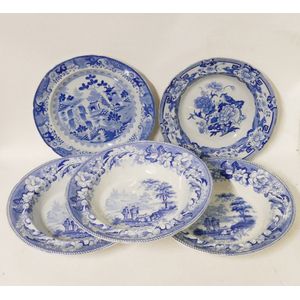Armorial Porcelain Platters, 19th Century
You must be a subscriber, and be logged in to view price and dealer details.
Subscribe Now to view actual auction price for this item
When you subscribe, you have the option of setting the currency in which to display prices to $Au, $US, $NZ or Stg.
- Armorial / Armourial - Bearing a coat of arms. Coats of arms came into general use by feudal lords and knights in in the 12th century, and by the 13th century, arms had spread beyond their initial battlefield use to become a flag or emblem for families in the higher social classes of Europe. They were inherited from one generation to the next. When a family crest is used on individual items of silver or furniture it is an indicator of the aristocratic standing of the family represented.
Armorials were also used to decorate mass produced ceramic souvenir ware by such companies as Goss, Carlton & Shelley, and in these cases the coats of arms displayed were of boroughs and cities. - Grisaille - Decorative painting in monochrome, usually shades of grey, olive green or buff, painted on wood, plaster, ceramic or stone surfaces to imitate marble figural sculpture or relief ornament.Grisaille, from the French "gris", or grey (colour) is a painting technique in which a monochrome image is created using only shades of gray, black and white, usually created by using a gray underpainting or a limited colour palette. It is often used to create the illusion of sculpture or relief on a flat surface, and was commonly used during the Renaissance and Baroque periods.
The technique of grisaille has been used in decorative arts for centuries. It was commonly used in the Renaissance and Baroque periods in Europe to create the illusion of sculptural relief on flat surfaces such as walls, ceilings, and furniture. This technique allowed artists to create the illusion of depth and dimensionality without the use of colour.
During the Rococo period, grisaille was often used in the production of ceramics and porcelain to create finely detailed designs on a white or light-colored surface.
In the 19th century, grisaille continued to be used in decorative arts, particularly in the production of ceramics, both Western and Oriental. - Transfer Printed / Decorated Transferware - Transfer printing is method of decorating ceramics, reducing the cost of decoration when compared to employing artists to paint each piece. A print was taken on transfer-paper from an engraved copperplate, covered in ink prepared with metallic oxides, and the image on the paper was then applied to the biscuit-fired ceramic body. The print was fixed by heating the object in an oven, and then glazed, sealing the picture. Early transfer prints were blue and white, as cobalt was the only colour to stand firing without blurring. Early in the 19th century advances in the composition of the transfer paper resulted in better definition and detail, and enabled engravers to combine line-engraving with stipple.
This item has been included into following indexes:
Visually similar items

Three Chinese Qing Dynasty blue and white porcelain plates, one of octagonal form decorated with house and lake scene, one decorated with house scene, one decorated with flowers and foliage accented with gilt, a/f, diameter 23 cm, 23.5 cm, 23 cm, (3)

Three Jiajing mark and period (1522-1566), blue and white bowl bases, and three with Xuande (1426-1435), mark but probably of later Ming dating; various designs, marks and sizes

Ten Ming dynasty (1368-1644), blue and white bowl bases, various designs, marks and sizes

Three Turner's blue and white dishes, and two Ironstone plates, one marked Mason's.
